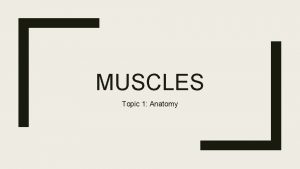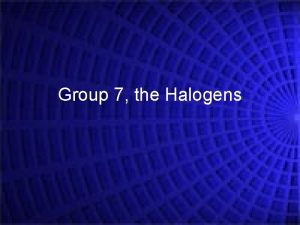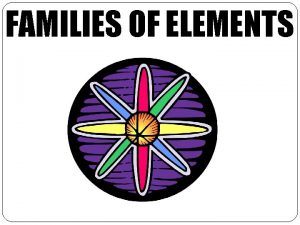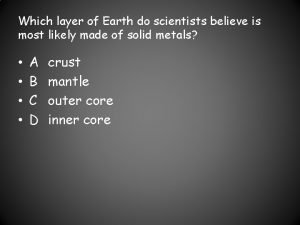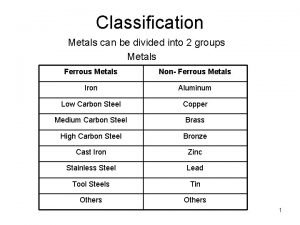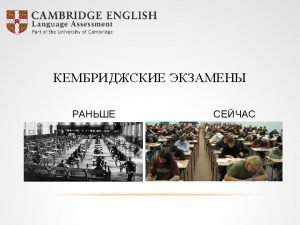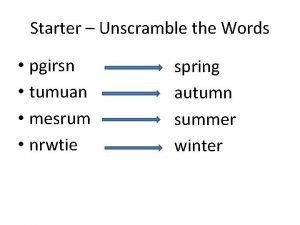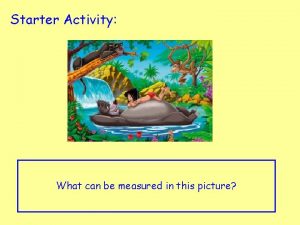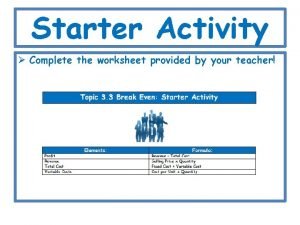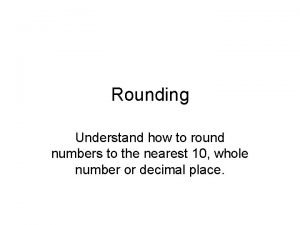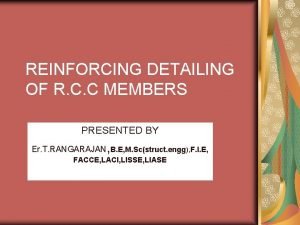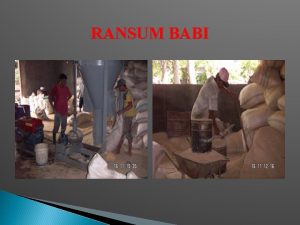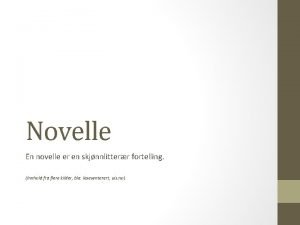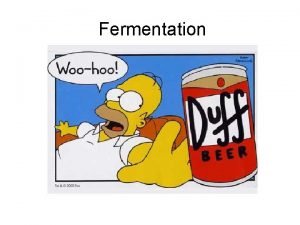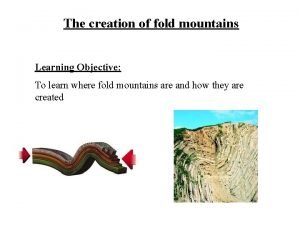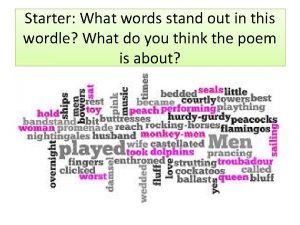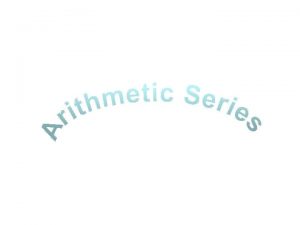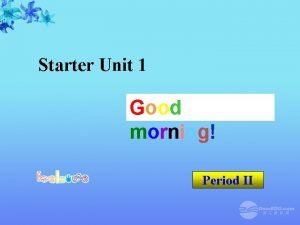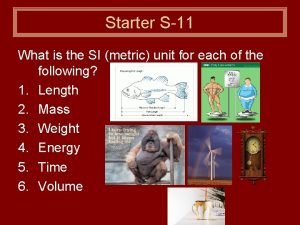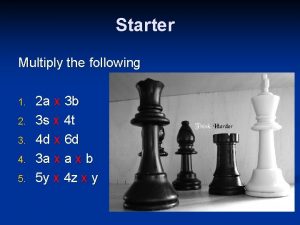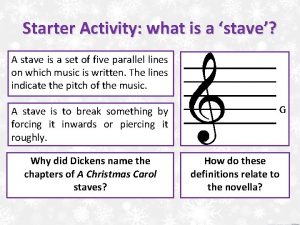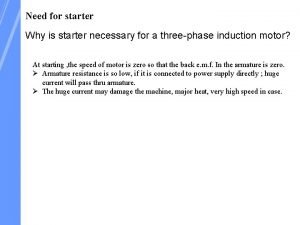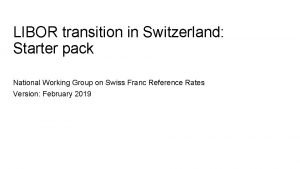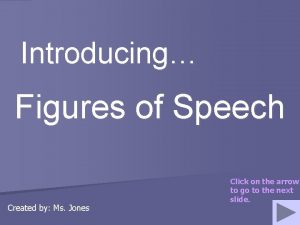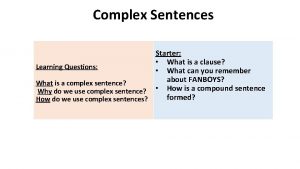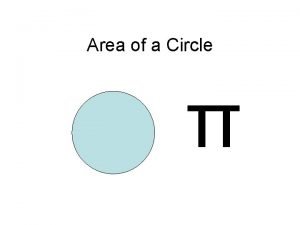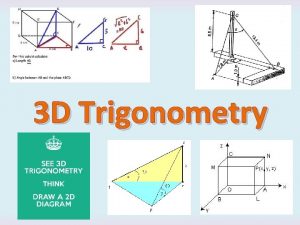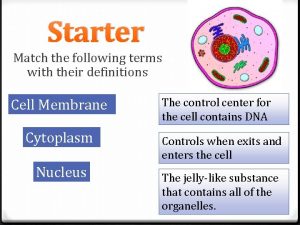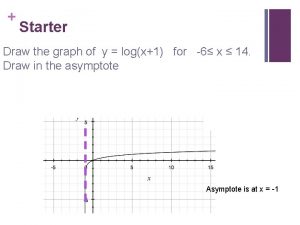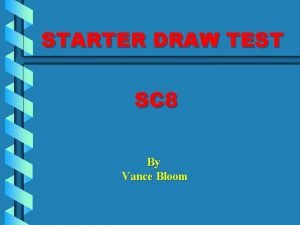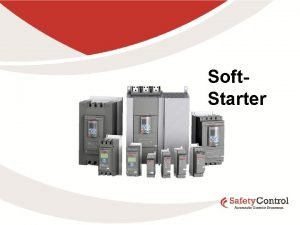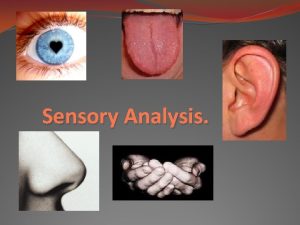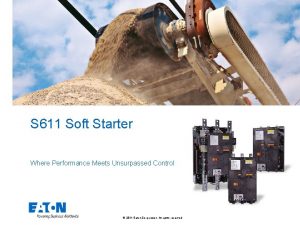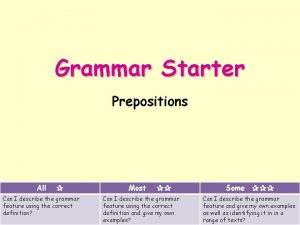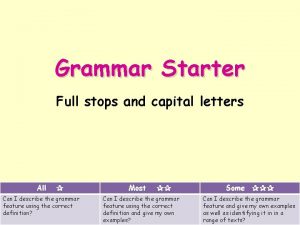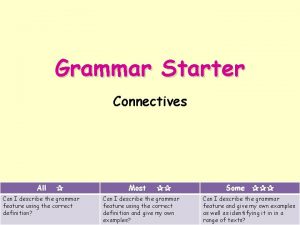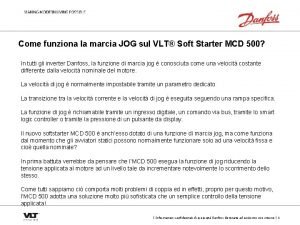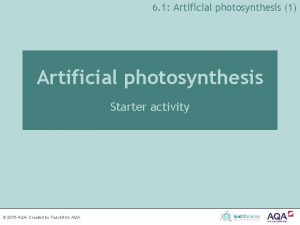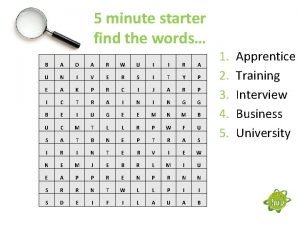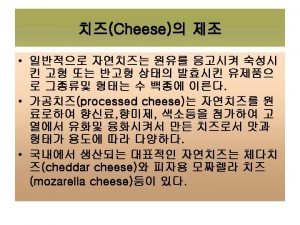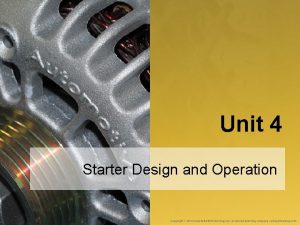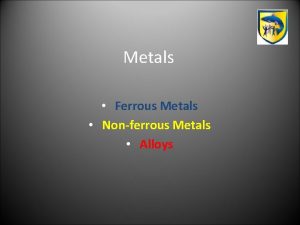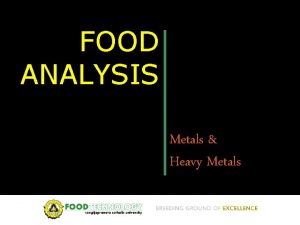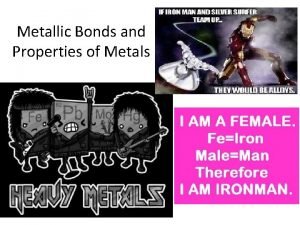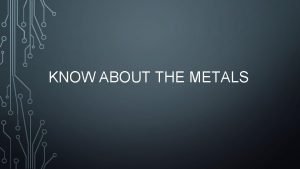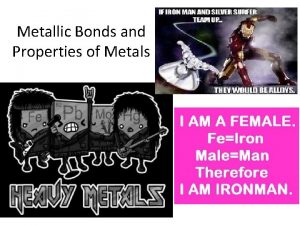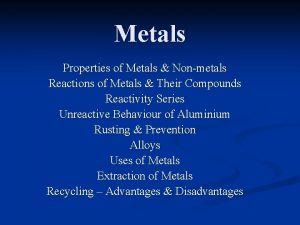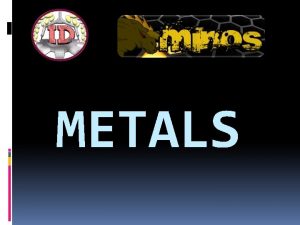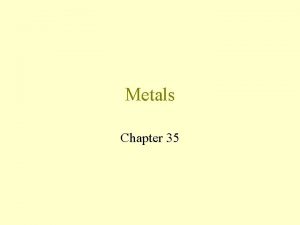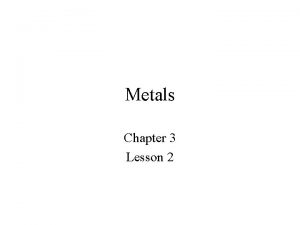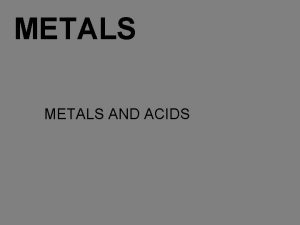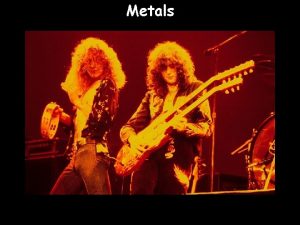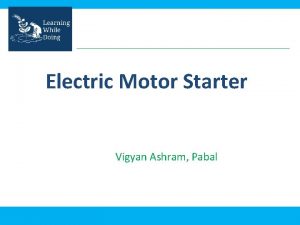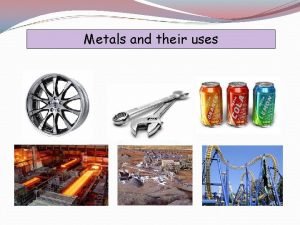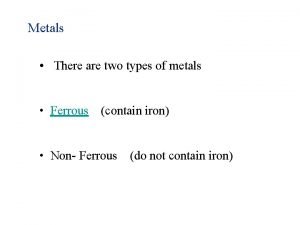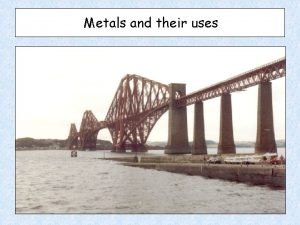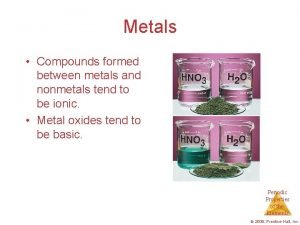METALS National 5 Starter Which of the following








































































































- Slides: 104

METALS National 5

Starter Which of the following diagrams could represent the structure of a metal ?

Lesson 1: Metals Today we are learning to understand some of the properties of metals. By the end of today I can: �Complete a table to show the boiling point/melting point of metals and conductivity of metals. �Explain metallic bonding

Metals • Metals have amazed and intrigued us for thousands of years. • From tungsten, the element with the highest melting point to lithium, a metal that floats on water; from gold, a metal so unreactive it is shiny even after thousands of years, to caesium, a metal so reactive it’s stored under a vacuum. • They can be used to create electricity and convert harmful car exhaust fumes into harmless gases, they can corrode but also protect. They can be strong and rigid or soft and supple, one is even a liquid. • Some are found as pure nuggets lying at the bottom of fast flowing rivers; others are so tightly bound to other elements, huge amounts of energy are required to separate them. • Metals are truly magical!

Activity 9. 1 Element Cadmium Calcium Gallium Tungsten Mercury Platinum Symbol M. P B. P State at 25˚C

Conductivity

�Set up either of the following electrical circuits to test the electrical conductivity of metals on the following table

(9. 2)Conductivity task:

Metallic bonding �Most metals are SOLIDS at room temperature and HARD with high melting/boiling points �All elements want to achieve a full outer electron shell. �Metals will give up 1, 2 or 3 electrons to form +ve metal ions

Metallic bonding �The greater the number of electrons in the outer shell the stronger the metallic bond. �So the melting point of Al>Mg>Na

Metallic elements Strong electrostatic forces exist between the delocalised electrons (free to move) and the positive metal ions formed due to the loss of outer electrons. These electrostatic attractions are known as metallic bonds.

Conducting electricity

Plenary flow chart: �Pupils to complete the flow chart in their jotters. �Follow the questions and answer for (a-d) substance z in each scenario.

Does it conduct electricity when solid? Does it conduct electricity when it is liquid? Does it have a high or low M. P or B. P? (a) (b) LOW (c) (d)

Lesson 2: Reactions of Metals

Metals Anagram �Conducting electricity is hugely important, but what other properties make metals amazing? �Unscramble these anagrams. ATHE RONOCTCDU LLAEMBEAL HSIYN LICDUTE WLO SDNYITE TTRGHESN

Lesson 2: Reaction of Metals Today we are learning to understand some of the reactions of metals. By the end of today I can: �List extra properties of metals �Understand how important the reactivity series is. �List some of the alkali metals in order of reactivity due to experiment demonstration. �State some of the reactions a metal can undergo.

(9. 3) Coloured compounds Fill in the table to show the colour of these ions. You may remember doing the flame test and may want to use your data booklet to help you

Reactions of metals �Some metals are more reactive than others. �The amount of energy given out when a metal reacts gives a measure of its reactivity. �By observing how vigorous the reaction is between a metal and: �WATER �OXYGEN �DILUTE ACID �We can begin to order the metals in a reactivity series

Reactivity Series Based on their reactivity, chemists produced a table of metals as shown:

Reaction with Water: The Alkali Metals (9. 5) �Observe the reaction between 3 alkali metals with water. �In your jotter record the reactivity of the three metals, note which gas is produced. �Write a word equation and balanced equation for the reaction of Potassium and water

Reaction with Water (9. 5) �Half fill three small (100 cm 3) beakers with water. �Into the first place half a spatula of calcium granules, the second half a spatula of magnesium powder and the third half a spatula of zinc powder. �Observe what happens (you may need to leave them for several minutes).


Metals Reacting with Water �ALL metals above aluminium in the reactivity series react with water to produce the metal hydroxide and hydrogen gas. �The metals from groups 1 and 2 react vigorously. METAL + WATER METAL HYDROXIDE + HYDROGEN

Example �Lithium + Water Lithium Hydroxide + + Hydrogen

Lesson 3

Starter: �What is the name given to the gas given off when an alkali metal is placed in water ? �Put the 3 metals observed in order of most reactive to least reactive �What colour would the water of gone if universal indicator was dropped into the glass bowl ?

(9. 6)Metals with acid: Half fill six test tubes with hydrochloric acid and place them in a test tube rack. Place a piece of magnesium, aluminium, zinc, iron, tin and copper into each test tube. Observe what happens.

Table of results:

Metals Reacting with Dilute Acid �Metals above hydrogen in the reactivity series react with acids to produce a salt and hydrogen gas. �Metals below HYDROGEN do not react with acids. METAL + ACID SALT + HYDROGEN

Example Zinc + Hydrochloric acid Zinc Chloride + Hydrogen

(9. 7)Metals with oxygen:

Table of results: Metal Observation Order of Reactivity

Metals Reacting with Oxygen �Some metals react vigorously with oxygen and burn Fiercely, some react more slowly and others do not react at all. METALS react with OXYGEN to make a METAL OXIDE. METAL + OXYGEN METAL OXIDE

Example Magnesium + Oxygen Magnesium O Oxide

Reactions of Metals and the Reactivity Series The results of experiments with Oxygen, water and dilute acids allow scientists to place metals into an order of reactivity.

A B Zinc D C Copper E Gold G F Carbon dioxide H Magnesium Hydrogen Calcium I Potassium Oxygen 1. Which boxes show metals which react with dilute acids? 2. Which boxes show metals which react with dilute acid but not with cold water? 3. Which boxes show metals that do not react with dilute acid? 4. Which boxes show metals which react with oxygen but not with a dilute acid? 5. Which box shows the gas produced when sodium reacts with water?

Lesson 4 Naming salts

Naming salts Salts have both a first and second name like us. The first part comes from the alkali/metal. The second part comes from the acid.


Metals and hydrochloric acidequations Magnesium + hydrochloric Magnesium chloride + acid hydrogen Aluminium +hydrochloric ____ +______ acid Zinc + hydrochloric ______ +_______ acid

Metal with sulfuric acid- equation Magnesium + sulfuric acid Magnesium + hydrogen sulfate Aluminium + _______ ____ + _______ + _____ _____ + _____

Metals and nitric acid- equations Magnesium +____ ______ +_____+_____ _____ + _____ _____ + ____


Challenge: �Create a word equation using any metal above hydrogen from the previous slide and one of the 3 acids we have been using.

Lesson 5 Ionic equations

Ionic equations Today we are learning to write ionic equations for some chemical reactions and about alloys By the end of today I can… �Write the ionic equation for some chemical reactions �State the definition for an alloy.

Ionic equations �Whenever a metal reacts it always turns in to a positive charged ion by losing it’s outer electrons to whatever it is reacting with. �The other reactants must gain these electrons and form an negative charged ion.

Example: Word equation: Sodium + Water Sodium hydroxide + hydrogen Chemical equation: 2 Na(s) + 2 H 2 O(l) Ionic equation: 2 Na(s) + 2 H 2 O(l) 2 Na. OH(aq) + H 2(g) 2[Na+](aq) + 2[OH-](aq) + H 2(g)

Word equation: magnesium + hydrochloric acid magnesium chloride +hydrogen Chemical equation: Mg(s) + 2 HCl(aq) Mg. Cl 2(aq) + H 2(g) Ionic equation: Mg(s)+2 H+(aq)+ 2 Cl-(aq) Mg 2+(aq)+2 Cl-(aq) + H 2(g)

Spectator ion: � If ions are not involved in a reaction, they are called SPECTATOR ions and are not shown in the final ionic equation: � Write ionic equations for the following chemical reactions: � A. Potassium + water potassium hydroxide + hydrogen � B. Zinc + hydrochloric acid zinc(II) chloride + hydrogen � C. Copper + oxygen copper(II) oxide

Alloys �When metals combine they do not form compounds, they just mix and form a mixture called an alloy. The physical properties of the metal change however, depending on the proportion of each metal. �For example solder is an alloy of tin and lead. It is used to join wires to components in circuit boards. On their own the tin was too hard and the lead too soft, but by mixing the tin and lead in the right proportion an alloy can be made which is easy to melt but hard enough to withstand impacts on the circuit board. �Some alloys contain one main metal with small quantities of other metals and some non-metals. Stainless steel contains mainly iron with small quantities of carbon, which makes it less brittle, and chromium, to make it shiny and corrosion resistant.

Gold Alloys Pure gold is a relatively soft metal and so it is not usually used to make jewellery. In order to make it stronger it is mixed with other metals such as copper and silver. Alloying also changes the colour of gold. Although alloying gold reduces its value, it is still valuable. The percentage of gold in an alloy is indicated by the number of carats (ct) it has. Pure gold is said to be 24 ct. The percentage of gold and other metals in some different alloys of ‘yellow’ gold are shown in the following table.

Carats (ct) Percentage gold (%) Percentage other metals (%) 22 91. 7 Ag: 5. o Cu: 2. 0 Zn: 1. 3 18 75. 0 Ag: 15. 0 Cu: 10. 0 14 58. 3 Ag: 30. 0 Cu: 11. 7 9 37. 5 Ag: 42. 5 Cu 20. 0

Lesson 6 Heat alone and Heat with Carbon

Starter: Lithium + water Lithium hydroxide + hydrogen Write the chemical equation and the ionic equation for the above reaction.

Learning intentions & success criteria �Today we are learning about extracting metals from their ores and extracting some metals from its ore with the aid of carbon. �By the end of today I can �State what metals are extracted with heat alone �State what metals are extracted with heat and carbon.

Extracting metals Metals exist in the earth’s crust as METAL ORES, the natural compound which they exist as. Metals are extracted from their ores in different ways, depending on the REACTIVITY of the metal. (More reactive metals are harder to separate from their ores. )

Heat alone (9. 9) � Heat Alone � 1. Put a spatulas of silver oxide in one test tube and a spatula of copper oxide in another. � 2. Heat strongly using a roaring Bunsen burner flame. � 3. Test for the presence of oxygen by placing a glowing splint into each test tube.

Heat alone Some metals can be extracted from their ore (metal oxide) by heat alone. This is only the case for the least reactive metals. metal oxide metal + oxygen

Extracting metals summary

(9. 10) Heat and Carbon � 1. Put two spatulas of copper oxide into a test tube. � 2. Hold the test tube with a test tube holder and heat using a roaring blue flame. � 3. Take a burning splint and plunge it into the hot copper oxide powder. � 4. Continue to heat the test tube. � 5. Pour the powder out onto a heat proof mat and look at the inside of the test tube, you should see copper on the inside of the glass. � 6. Repeat the experiment with iron(III) oxide.

Heat and Carbon �Metals that are slightly more reactive were only discovered when their ore was accidently dropped in a fire. The heat and the carbon caused the metal to be displaced and the carbon to join up with the oxygen. This was eventually known as smelting. �The carbon is called a reducing agent.

�It was later found that a much higher temperature was required to extract iron. To achieve this they needed to blow hot air into what was called a Blast Furnace; the oxygen reacted with the carbon to form carbon monoxide which then reacted with the iron oxide. � iron(III) + carbon iron + carbon dioxide monoxide


Lesson 7 Electrolysis

Starter: �What metal did we try to extract with heat and carbon ? �Why did we use a wooden peg to grip the test tubes ? �Why did we aim the test tubes at the wall ? �How would you conduct this experiment on a large scale ?

Learning intentions & Success criteria Today we are learning about electrolysis and the percentage of metal in an ore. By the end of today I can… � state the definition for electrolysis �Calculate the percentage of metal present in an ore.

(9. 11)Electrolysis

Extracting metals summary:

Percentage of Metal in an Ore

Work out the %of metal in the following ores: �copper(II) carbonate Cu. CO 3 �lead(IV) oxide Pb. O 2 �aluminium oxide Al 2 O 3

�Tenorite Cu 2 O is an ore of copper. Given that copper has a mass of 63. 5 and oxygen a mass of 16, calculate the percentage by mass of copper in tenorite. �Gibbsite Al(OH)3 is a mineral found in aluminium ore. Given the relative atomic mass of aluminium is 27, oxygen is 16 and hydrogen is 1, calculate the percentage by mass of gibbsite that is aluminium.

Electrochemical cells

Starter: �Chalcopyrite (Fe. S 2) �Siderite (Fe. CO 3) �Cinnabar (Hg. S) �Calculate the percentage composition that is a metal in each of these examples.

Learning Intentions and Success Criteria �Learning Intention �To learn about the different components of an electrochemical cell �To learn about the significance of electrochemical cells within chemistry �Success Criteria �I can recall information about the electrochemical series �I can interpret data within the data booklet �I can differentiate the different components of the electrochemical cell �I can distinguish the accepting metal and receiving metal within the electrochemical cell


(9. 13) A Lemon Cell

(9. 14)Experiment


Electrochemical series

Plenary �On your exit ticket write the answer yes or no to the following question: �Would a voltage be produced in the following experiment set up ?

Redox And Displacement

Starter �Which way do the electrons flow within each cell �Which cell would have the biggest voltage Mg Cu Mg Al Cu Cu

Recap �In the last lesson we looked at the lemon cell demo and a simple electrochemical cell where the metals were changed. �In the practical it was found that the metal higher up the electrochemical series donated its electrons to the metal lower down the electrochemical series.

Learning Intention and Success Criteria �Learning Intentions �To learn about the processes of oxidation and reduction �To learn about reduction and oxidation half equations �To learn about redox equations �To learn about displacement reactions �Success Criteria �I can state the processes of reduction and oxidation �I can recognise the processes of reduction and oxidation �I can recall the OIL RIG Memory aid �I can manipulate reduction and oxidation half equations

Summary of experiment As the electrons flow from one metal to the other, one metal must donate electrons and the other accept them. You can see from the table that some metals are better at donating electrons and some metals better at accepting them. If we place the metals in order of their ability to donate electrons we form what is known as the electrochemical series. Metals good at donating electrons are at the top and the metals at the bottom are better at accepting electrons.

Electrochemical Cells �Electrically conducting solutions containing ions are known as electrolytes. �A simple cell can be made by placing two metals in an electrolyte. �Another type of cell can be made using two half-cells (metals in solutions of their own ions). �An ‘ion bridge’ (salt bridge) can be used to link the half-cells. Ions can move across the bridge to complete an electrical circuit.

�Electricity can be produced in cells where at least one of the half-cells does not involve metal atoms/ions. A graphite rod can be used as the electrode in such half-cells. �Different pairs of metals produce different voltages. These voltages can be used to arrange the elements into an electrochemical series. �The further apart elements are in the electrochemical series, the greater the voltage produced when they are used to make an electrochemical cell. �Electrons flow in the external circuit from the species higher in the electrochemical series to the one lower in the electrochemical series.






Redox

Electrolysis = Redox

Examples: Copper and bromine ions (making copper solid and bromine gas) Magnesium and chlorine ions (making solid silver and chlorine gas) Calcium and iodide ions (making calcium solid and iodine solid)

Displacement reaction


Redox- Displacement


(9. 16) Redox Reactions Try these three experiments: � 1. Pour out 2 cm depth of copper(II) sulfate solution into a test-tube, add a spatula of iron filings. Put a rubber bung in and shake. Observe what happens. � 2. Pour out 2 cm depth of hydrochloric acid into a test-tube and add a strip of magnesium ribbon. Observe what happens. � 3. Pour out 2 cm depth of iodine solution into a test-tube and add a spatula of sodium sulfite. Observe what happens.


Plenary �On your exit ticket write the memory trick used to remember oxidation and reduction.
 Metals and non metals in the periodic table
Metals and non metals in the periodic table Ferrous metals vs non ferrous metals
Ferrous metals vs non ferrous metals Metals vs nonmetals
Metals vs nonmetals Matter and materials grade 7
Matter and materials grade 7 Natural science grade 7 lesson plans term 2
Natural science grade 7 lesson plans term 2 Reactivity in periodic table
Reactivity in periodic table Structure of skeletal muscle
Structure of skeletal muscle Halides in periodic table
Halides in periodic table Elements in group 1
Elements in group 1 Which layer of earth is most likely made of solid metals
Which layer of earth is most likely made of solid metals Classification of ferrous metals
Classification of ferrous metals What are variable charge ions
What are variable charge ions Hát kết hợp bộ gõ cơ thể
Hát kết hợp bộ gõ cơ thể Slidetodoc
Slidetodoc Bổ thể
Bổ thể Tỉ lệ cơ thể trẻ em
Tỉ lệ cơ thể trẻ em Voi kéo gỗ như thế nào
Voi kéo gỗ như thế nào Chụp phim tư thế worms-breton
Chụp phim tư thế worms-breton Hát lên người ơi alleluia
Hát lên người ơi alleluia Các môn thể thao bắt đầu bằng tiếng nhảy
Các môn thể thao bắt đầu bằng tiếng nhảy Thế nào là hệ số cao nhất
Thế nào là hệ số cao nhất Các châu lục và đại dương trên thế giới
Các châu lục và đại dương trên thế giới Công thức tính thế năng
Công thức tính thế năng Trời xanh đây là của chúng ta thể thơ
Trời xanh đây là của chúng ta thể thơ Cách giải mật thư tọa độ
Cách giải mật thư tọa độ Làm thế nào để 102-1=99
Làm thế nào để 102-1=99 độ dài liên kết
độ dài liên kết Các châu lục và đại dương trên thế giới
Các châu lục và đại dương trên thế giới Thể thơ truyền thống
Thể thơ truyền thống Quá trình desamine hóa có thể tạo ra
Quá trình desamine hóa có thể tạo ra Một số thể thơ truyền thống
Một số thể thơ truyền thống Bàn tay mà dây bẩn
Bàn tay mà dây bẩn Vẽ hình chiếu vuông góc của vật thể sau
Vẽ hình chiếu vuông góc của vật thể sau Nguyên nhân của sự mỏi cơ sinh 8
Nguyên nhân của sự mỏi cơ sinh 8 đặc điểm cơ thể của người tối cổ
đặc điểm cơ thể của người tối cổ Giọng cùng tên là
Giọng cùng tên là Vẽ hình chiếu đứng bằng cạnh của vật thể
Vẽ hình chiếu đứng bằng cạnh của vật thể Vẽ hình chiếu vuông góc của vật thể sau
Vẽ hình chiếu vuông góc của vật thể sau Thẻ vin
Thẻ vin đại từ thay thế
đại từ thay thế điện thế nghỉ
điện thế nghỉ Tư thế ngồi viết
Tư thế ngồi viết Diễn thế sinh thái là
Diễn thế sinh thái là Dạng đột biến một nhiễm là
Dạng đột biến một nhiễm là So nguyen to
So nguyen to Tư thế ngồi viết
Tư thế ngồi viết Lời thề hippocrates
Lời thề hippocrates Thiếu nhi thế giới liên hoan
Thiếu nhi thế giới liên hoan ưu thế lai là gì
ưu thế lai là gì Hổ đẻ mỗi lứa mấy con
Hổ đẻ mỗi lứa mấy con Khi nào hổ con có thể sống độc lập
Khi nào hổ con có thể sống độc lập Sơ đồ cơ thể người
Sơ đồ cơ thể người Từ ngữ thể hiện lòng nhân hậu
Từ ngữ thể hiện lòng nhân hậu Thế nào là mạng điện lắp đặt kiểu nổi
Thế nào là mạng điện lắp đặt kiểu nổi Starters movers flyers ket pet fce cae
Starters movers flyers ket pet fce cae Pictogram starter
Pictogram starter Reichstag fire who was the fire starter
Reichstag fire who was the fire starter Unscramble starter
Unscramble starter What is directional and non directional hypothesis
What is directional and non directional hypothesis Starter background
Starter background Starter activity clipart
Starter activity clipart Starter activity
Starter activity Solving equations starter
Solving equations starter Rounding starter
Rounding starter Romeo and juliet starter
Romeo and juliet starter How to calculate haunch bar length
How to calculate haunch bar length Tabel pemberian pakan babi
Tabel pemberian pakan babi Novelle om fortellinger
Novelle om fortellinger Midlife crisis starter pack
Midlife crisis starter pack Biological ennoblement
Biological ennoblement When the starter is bent upward into simple upfold called
When the starter is bent upward into simple upfold called Wordle starter words
Wordle starter words Nth term starter
Nth term starter Unit 1 good morning
Unit 1 good morning Good morning starter
Good morning starter Starter s11
Starter s11 Multiply starter
Multiply starter What is a stave
What is a stave Quadrat
Quadrat Hc cargo denmark
Hc cargo denmark Stator resistance starter
Stator resistance starter National working group on swiss franc reference rates
National working group on swiss franc reference rates The willow tree shook her long hair
The willow tree shook her long hair Maths bot starter generator
Maths bot starter generator Broiler feeding schedule
Broiler feeding schedule Complex sentences starters
Complex sentences starters Circle starter
Circle starter An inspector calls starter activities
An inspector calls starter activities Trigonometry starter
Trigonometry starter Introduction match the terms with their definitions
Introduction match the terms with their definitions Graph starter
Graph starter Starter draw test
Starter draw test Partida direta vantagens e desvantagens
Partida direta vantagens e desvantagens Analysis starter
Analysis starter S611 soft starter
S611 soft starter Rebel starter pack
Rebel starter pack Preposition starter
Preposition starter Grammar starter
Grammar starter Connectives starter
Connectives starter Soft starter funzionamento
Soft starter funzionamento Photosynthesis starter activity
Photosynthesis starter activity 5 minute starter activities
5 minute starter activities Starter
Starter 1262020 starter
1262020 starter The revolving component of the starter is the:
The revolving component of the starter is the:






